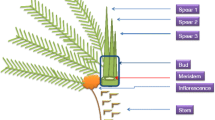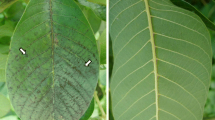Abstract
Ustilago esculenta is a biotrophic smut fungus that parasitizes Zizania latifolia, an edible aquatic vegetable of the southern China region. Infection results in swelling of the upper parts of the Z. latifolia culm which are called jiaobai and have a unique flavor and delicacy and are popular among Chinese. The infection process of Z. latifolia by U. esculenta was investigated with light and electron microscopy. Distribution of hyphae was uneven in plants; hyphae were mainly present in the swollen upper parts (jiaobai), the nodal regions of mature culms and old rhizomes and buds or shoots. Hyphae were rare in the internodes of mature culms and were fewer in the internodes of old rhizomes. All new buds produced on the nodes of culms and rhizomes were infected by hyphae in November before and in March after overwintering. The hyphae grew into the buds from the parent nodes via intervascular tissues only or via parenchyma tissues and vascular bundles. Hyphae extended within and between the host cells and frequently formed hyphal aggregations or clusters, not only in the mature tissues but also in developing tissues. The typical interface between the fungal hyphal wall and invaginated host plasma membrane comprised a sheath. The sheath surrounding a hyphae comprised an outer electron-opaque matrix and an inner electron-dense layer. The electron-opaque matrix layers were thicker in jiaobai tissues, ranging from 0.28 to 0.85 μm. The electron-dense hyphal coatings were more conspicuous in the young buds or shoots and mature culms than in the jiaobai. The intercellular hyphae caused large cavity formation between the cells or rupture of host cell walls, for gaining entry into host cells. The broken host cell wall fused with the electron-opaque matrix of the hyphal sheath as an interactive interface. The teliospore wall and wall ornamentation development was the same in postmature jiaobai tissues with sporadic sori and in the huijiao (jiaobai tissues containing the massive sori), but a sheath enveloping the teliospore was more transparent in the process of teliospore development in the jiaobai than in the huijiao.





Similar content being viewed by others
References
Alexander HM, Antonovics J (1988) Disease spread and population dynamics of anther-smut infection of Silene alba caused by the fungus Ustilago violacea. J Ecol 76:91–104
Bauer R, Mendgen K, Oberwinkler F (1995) Cellular interaction of the smut fungus Ustacystis waldsteiniae. Can J Bot 73:867–883
Bauer R, Oberwinkler F, Vánky K (1997) Ultrastructural markers and systematics in smut fungi and allied taxa. Can J Bot 75:1273–1314
Brefort T, Doehlemann G, Mendoza-Mendoza A, Reissmann S, Djamei A, Kahmann R (2009) Ustilago maydis as a pathogen. Annu Rev Phytopathol 47:423–425
Chan YS, Thrower LB (1980) The host-parasite relationship between Zizania caduciflora Turcz and Ustilago esculenta P. Henn. I. Structure and development of the host and host- parasite combination. New Phytol 85:201–207
Chung KR, Tzeng DD (2004) Nutritional requirements of the edible gall-producing fungus Ustilago esculenta. J Biol Sci 4:246–252
Doehlemann G, van der Linde K, Amann D, Schwammbach D, Hof A, Mohanty A, Jackson D, Kahmann R (2009) Pep1, a secreted effector protein of Ustilago maydis, is required for successful invasion of plant cells. PLoS Pathog 5:e1000290
Doehlemann G, Wahl R, Vranes M, de Vries RP, Kämper J (2008) Establishment of compatibility in the Ustilago maydis/maize pathosystem. J Plant Physiol 165:29–40
Fullerton RA (1975) A histological study of the grass Heteropogon contortus infected by the smut Sorosporium caledonicum. Aust J Bot 23:51–54
Guo HB, Li SM, Peng J, Ke WD (2007) Zizania latifolia Turcz. Cultivated in China. Genet Resour Crop Evol 54:1211–1217
Hu GG, Linning R, Bakkeren G (2002) Sporidial mating and infection process of the smut fungus, Ustilago hordei, in susceptible barley. Can J Bot 80:1103–1114
Kämper J, Kahmann R, Bölker M, Ma LJ, Brefort T (2006) Insights from the genome of the biotrophic fungal plant pathogen Ustilago maydis. Nature 444:97–101
Nagler A, Bauer R, Oberwinkler F, Tschen J (1990) Basidial development, spindle pole body, septal pore, and host-parasite interaction in Ustilago esculenta. Nord J Bot 10:457–464
Piepenbring M, Bauer R, Oberwinkler F (1998a) Teliospores of smut fungi: Teliospore walls and the development of ornamentation studied by electron microscopy. Protoplasma 204:170–201
Piepenbring M, Bauer R, Oberwinkler F (1998b) Teliospores of smut fungi-Teliospore connections, appendages, and germ pores studied by electron microscopy; phylogenetic discussion of characteristics of teliospores. Protoplasma 204:202–218
Piepenbring M, Stoll M, Oberwinkler F (2002) The generic position of Ustilago maydis, Ustilago scitaminea, and Ustilago esculenta (Ustilaginales). Mycol Prog 1:71–80
Sampedro J, Cosgrove DJ (2005) The expansin superfamily. Genome Biol 6:242–250
Sun H, Zhang JZ (2009) Colletotrichum destructivum from cowpea infecting Arabidopsis thaliana and its identity to C. higginsianum. Eur. J. Plant Pathol 125:459–469
Terrell EE, Batra LR (1982) Zizania latifolia and Ustilago esculenta, a grass-fungus association. Econ Bot 36:274–285
Vánky K (2002) Illustrated genera of smut fungi, 2nd edn. APS Press, St. Paul, Minnesota
Xu C, Hu MH, Guo DP (2009) Current status and prospects of aquatic vegetable industry in Zhejiang province. J ChangJiang Veget 16:106–109
Xu XW, Walters C, Antolin MF, Alexander ML, Lutz S, Ge S, Wen J (2010) Phylogeny and biogeography of the eastern Asian-North American disjunct wild-rice genus (Zizania L., Poaceae). Mol Phylogenet Evol 55:1008–1017
Yang HC, Leu LS (1978) Formation and histopathology of galls induced by Ustilago esculenta in Zizania latifolia. Phytopathology 68:1572–1576
You WY, Liu Q, Zou KQ, Yu XP, Cui HF, Ye ZH (2010) Morphological and molecular differences in two strains of Ustilago esculenta. Curr Microbiol 62:44–54
Acknowledgement
This work was supported by The Special Fund for Agro-scientific Research in the Public Interest of China (No: 200903017–03).
Author information
Authors and Affiliations
Corresponding authors
Rights and permissions
About this article
Cite this article
Zhang, JZ., Chu, FQ., Guo, DP. et al. Cytology and ultrastructure of interactions between Ustilago esculenta and Zizania latifolia . Mycol Progress 11, 499–508 (2012). https://doi.org/10.1007/s11557-011-0765-y
Received:
Revised:
Accepted:
Published:
Issue Date:
DOI: https://doi.org/10.1007/s11557-011-0765-y




